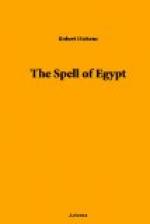There are some fine reliefs scattered through these mighty ruins, showing Sebek with the head of a crocodile, Heru-ur with the head of a hawk so characteristic of Horus, and one strange animal which has no fewer than four heads, apparently meant for the heads of lions. One relief which I specially noticed for its life, its charming vivacity, and its almost amusing fidelity to details unchanged to-day, depicts a number of ducks in full flight near a mass of lotus-flowers. I remembered it one day in the Fayum, so intimately associated with Sebek, when I rode twenty miles out from camp on a dromedary to the end of the great lake of Kurun, where the sand wastes of the Libyan desert stretch to the pale and waveless waters which, that day, looked curiously desolate and even sinister under a low, grey sky. Beyond the wiry tamarisk-bushes, which grow far out from the shore, thousands upon thousands of wild duck were floating as far as the eyes could see. We took a strange native boat, manned by two half-naked fishermen, and were rowed with big, broad-bladed oars out upon the silent flood that the silent desert surrounded. But the duck were too wary ever to let us get within range of them. As we drew gently near, they rose in black throngs, and skimmed low into the distance of the wintry landscape, trailing their legs behind them, like the duck on the wall of Kom Ombos. There was no duck for dinner in camp that night, and the cook was inconsolable. But I had seen a relief come to life, and surmounted my disappointment.
Kom Ombos and Edfu, the two houses of the lovers and haters of crocodiles, or at least of the lovers and the haters of their worship, I shall always think of them together, because I drifted on the Loulia from one to the other, and saw no interesting temple between them and because their personalities are as opposed as were, centuries ago, the tenets of those who adored within them. The Egyptians of old were devoted to the hunting of crocodiles, which once abounded in the reaches of the Nile between Assuan and Luxor, and also much lower down. But I believe that no reliefs, or paintings, of this sport are to be found upon the walls of the temples and the tombs. The fear of Sebek, perhaps, prevailed even over the dwellers about the temple of Edfu. Yet how could fear of any crocodile god infect the souls of those who were privileged to worship in such a temple, or even




